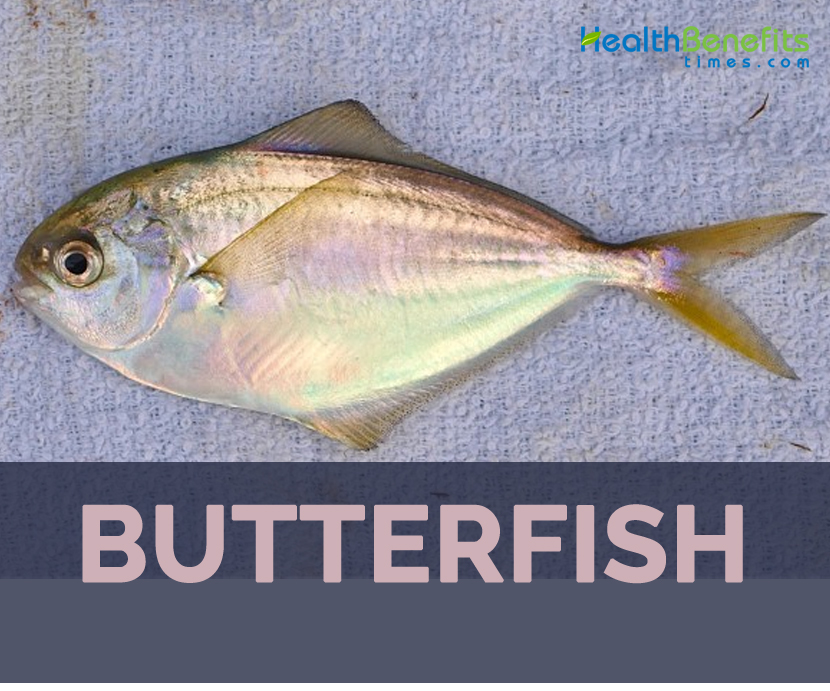| Butterfish Quick Facts | |
|---|---|
| Name: | Butterfish |
| Origin | New Zealand |
| Colors | Leaden bluish above, pale on the sides, with numerous irregular dark spots which fade after death. The belly is silvery. |
| Shapes | About 12 inches long; the general run are about 6 to 9 inches long. |
| Calories | 47 Kcal./cup |
| Major nutrients | Vitamin B-12 (25.42%) Selenium (21.27%) Isoleucine (15.25%) Lysine (15.19%) Tryptophan (14.09%) |
| More facts about Butterfish | |
The delicate and delicious butterfish is endemic to New Zealand and is a source of several nutrients important for human health, including iodine. Some of the characteristic features of butterfish are blunt noses, small mouths with weak teeth, absence of ventral fins, one long, continuous dorsal fin, long pectoral fins, and tiny, cycloid scales. The tail fin is nearly as long as the dorsal fin and deeply forked. The American butterfish is comparable in appearance to its close relative, the harvestfish (Peprilus alepidotus), but can be distinguished by its much lower dorsal and tail fin. This fish is a lead-blue color above with pale sides and a silvery belly. It often has dark, irregular spots.
The largest butterfish are about 12 inches long; the general run is about 6 to 9 inches long. The weight runs about 1¾ ounces at 6 inches, 4 to 4½ ounces at 8 inches; about 1 pound at 11 inches (if fat). The largest weigh about 1¼ pounds. Butterfish normally feed on planktonic prey like coelenterates, thaliaceans, polychaetes, mollusks, crustaceans and small fishes. Ctenophores have been found in butterfish stomachs at Woods Hole, though these watery objects are not a regular item in its diet.
Butterfish consists of good amount of protein which makes them less likely to contribute to weight gain. Each 3-ounce serving of butterfish offers 19 grams of protein, or 38 percent of the recommended daily intake. Protein slows down the emptying of food from the stomach so that you feel full for longer after a meal. That means you may feel less hungry at the next meal and eat fewer calories.
History
Butterfish are widespread to New Zealand, and occur from North Cape to the Snares Islands. The species is also reported from the Chatham, Bounty and Antipodes Islands. Butterfish are more common from Cook Strait southwards. They inhabit rocky coastlines, and are commonly found among seaweed beds in moderately turbulent water. Their main depth range is 0–20 m. They occur shallower (to 10 m) in the north than in Cook Strait (to 20 m) and in southern waters they can be found as deep as 40 m.
Nutritional Value
Apart from their wonderful taste, butterfish is a good source of nutrients, vitamins and minerals. Consuming 32 gram of butterfish offers 0.61 µg of Vitamin B-12, 11.7 µg of Selenium, 5.53 g of Protein, 77 mg of Phosphorus, 1.44 mg of Vitamin B3, 0.096 mg of Vitamin B6, 2.57 g of Total Fat, 0.24 mg of Vitamin B5 and 0.048 mg of Vitamin B2. Moreover many Amino acids 0.062 g of Tryptophan, 0.243 g of Threonine, 0.255 g of Isoleucine, 0.45 g of Leucine, 0.508 g of Lysine, 0.164 g of Methionine are also found in 32 gram of butterfish.
How to Eat
- Small fish can be dipped whole in flour and deep fried.
- Larger fish can be split, then broiled, baked, grilled, or sautéed
How to Cook Butterfish
Things You’ll Need
- 6 ounces butterfish fillets
- Paper towel
- Salt and pepper
- Grill pan
- Non-stick cooking spray
- Serving platter
Method
- Rinse the butterfish in cold water and pat the outside dry with a paper towel.
- Season both sides of the fish with salt and pepper. Allow the fish to sit at room temperature for 30 minutes.
- Spray a grill pan with non-stick cooking spray and preheat it to medium heat.
- Place the butterfish fillets in the grill pan and cook them for three minutes. Flip the fish and cook another three minutes on the other side.
- Remove the fish from the pan and place it on a platter to rest for 10 minutes before serving so the fish will be moist.
Other Facts
- Butterfish are important food fish and have been harvested commercially since the 1800s. In the early 1900s, they were used primarily as fertilizer but were discovered to be a fish suitable for eating as well.
- Often used as bait in recreational fishing, butterfish is a favorite food source for large game fish such as tuna.
Precautions
You should never eat more than 6 ounces in a meal, because butterfish can cause the sickness known as keriorrhea. Keriorrhea turns your stool orange and is caused by ingesting the indigestible waxy esters that butterfish contain. Eating the fish closer to the tail reduces this risk.
References:
http://www.gma.org/fogm/poronotus_triacanthus.htm
http://wildblue.co.nz/Info/Fish+ID+and+Tactics/Reef+Species/Butterfish.html
http://fs.fish.govt.nz/Doc/21709/12_BUT_09.pdf.ashx
https://www.jstor.org/stable/20494547?seq=1#page_scan_tab_contents
http://www.risaa.org/newsletter/0315/0315_13.pdf
http://www.nefsc.noaa.gov/fbp/age-man/butt/butt.htm
http://www.edc.uri.edu/restoration/html/gallery/fish/butter.htm
Comments
comments
